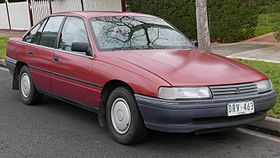Holden Commodore (VN)
| Holden Commodore (VN) | |
|---|---|

Holden Commodore Executive sedan
|
|
| Overview | |
| Manufacturer | Holden (General Motors) |
| Also called | Holden Utility (VG) Toyota Lexcen (T1) |
| Production | 1988–1991 |
| Assembly | Australia: Elizabeth, South Australia New Zealand: Trentham (1988–1990) |
| Body and chassis | |
| Class | Full-size car |
| Body style | 4-door sedan 4-door station wagon 2-door coupé utility (VG) |
| Layout | Front-engine, rear-wheel-drive |
| Platform | GM V platform |
| Related |
Holden Statesman/Caprice (VQ) Opel Omega Opel Senator |
| Powertrain | |
| Engine | 2.0 L C20NE I4 (gasoline) 3.8 L 3800 V6 (gasoline) 5.0 L HEC 5000i V8 (gasoline) |
| Transmission | 5-speed Borg-Warner T-5 manual 4-speed GM HydraMatic 700 automatic |
| Dimensions | |
| Wheelbase | 2,731 mm (107.5 in)–2,822 mm (111.1 in) |
| Length | 4,850 mm (191 in)–4,896 mm (192.8 in) |
| Width | 1,794 mm (70.6 in)–1,802 mm (70.9 in) |
| Height | 1,400 mm (55 in)–1,474 mm (58.0 in) |
| Curb weight | 1,311 kg (2,890 lb)–1,492 kg (3,289 lb) |
| Chronology | |
| Predecessor | Holden Commodore (VL) |
| Successor | Holden Commodore (VP) |
The Holden Commodore (VN) is a full-size car that was produced by the Australian manufacturer Holden from 1988 to 1991. It was the first iteration of the second generation of this Australian made model, which was previously a mid-size car. The new range included the luxury variants, Holden Berlina (VN) and Holden Calais (VN) and, from 1990, introduced the commercial Holden Utility (VG).
The VN series was released on 17 August 1988 and it was a re-engineered hybrid of the European Opel Omega and Opel Senator. This donor body was paired to a Buick V6 engine or the Holden V8 engine. The project cost some A$200 million.
As well as being highly based on the Opel Senator, the VN also was similarly based on the Opel Omega, but this time, the previous VL Commodore floor plan was widened and stretched. The Commodore could now match the rival Ford Falcon for size. The VN Commodore was available in Executive, S, SS, Berlina and Calais specification levels, although a more basic SL model (opt. code A9K) was supposedly offered to government and fleet buyers, as it was not officially listed as part of the Commodore range. The VN Commodore was also awarded Wheels Car of the Year for a second time in 1988. For the first time since 1984, Holden again offered a commercial coupe utility with the first-Commodore based VG Utility sold from August 1990. The Holden Statesman and Caprice (VQ) models, which were introduced in March 1990, were also VN Commodore based, but shared a longer wheelbase with the VN Commodore wagon and VG Utility.
Changes in the relative values of the Australian dollar, the Japanese yen, and the US dollar made it impractical to continue with the well-regarded Nissan engine of the VL. Instead, Holden manufactured their own 90-degree V6 based on an old Buick design from the US, although initially it was imported. The 5.0-litre V8 remained optional and received a power boost to 165 kW (221 hp). Both these engines used multi point GM EFI and the V6 using 3 coil-packs for ignition. Although not known for its smoothness or quietness, the V6 was nevertheless praised for its performance at the time. A fuel-injected, 2.0-litre four-cylinder VN Commodore model was offered for some export markets including New Zealand and Singapore, which were sold as the Holden Berlina sharing an engine with the Opel Vectra A. Accompanying the changes to engines, the four-speed Jatco automatic transmission was replaced by the GM TH700 (also with four speeds) and the Borg-Warner T-5 five-speed manual gearbox.
...
Wikipedia
